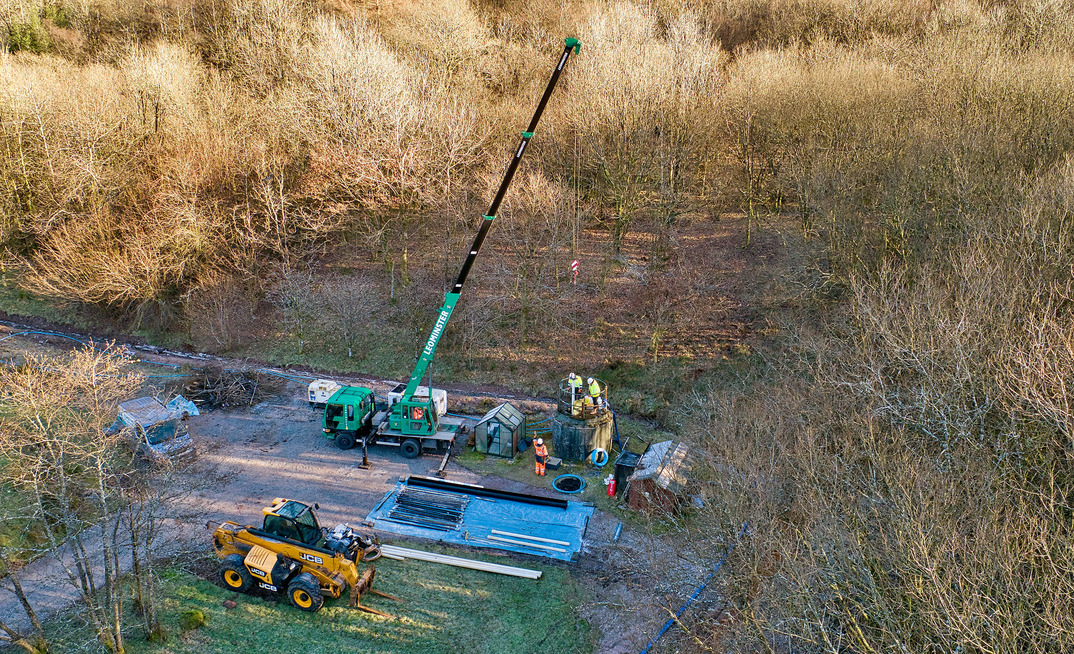A borehole that played a critical role in a commercial bottling operation had seen a significant decline in yield. Richard Lane, Director, Drift Services Group, explains how the reduction in flow volume and - more concerningly - water quality posed challenges.
Ensuring a steady and high-quality water supply was essential for the client to maintain operational efficiency and regulatory compliance. Drift Services Group was commissioned to undertake a comprehensive borehole rehabilitation and testing programme to restore its efficiency and functionality. This case study details the process and the resultant benefits.
Our client's primary objective was to rejuvenate the borehole, improving its yield and water quality while ensuring compliance with commercial bottling industry standards. Our approach focused on identifying and mitigating the factors contributing to the borehole's declining performance and equipping it for sustainable future use.
Cleaning
The first step was literally cleaning up the borehole. Years of iron build-up and fouling had accumulated on the liner walls, severely impacting the well's efficiency. To address this, we employed a series of advanced borehole maintenance tools and techniques:
· Borehole scrubbing: this is a mechanical cleaning process that physically removes debris and encrustations from borehole walls, addressing the primary sources of blockages.
· Jetting: high-pressure water jets can then be used to dislodge any stubborn deposits and enhanced the borehole's permeability.
· Development pumping: by forcing water in and out of the borehole, we flushed out any remaining fine particles and impurities, further improving water flow.
· Chemical treatments: carefully selected chemical agents were also used on this occasion to break down and dislodge iron-related deposits that the mechanical methods alone could not address. These treatments targeted the biofouling and mineral scale buildup responsible for reduced water quality and flow.
Together, these cleaning processes removed years of fouling, restoring the borehole's flow efficiency and capacity.
Sterilisation
After the cleaning process, the borehole was disinfected and sterilised to eliminate any microbial contamination. This step was crucial for ensuring the water quality met the high standards required for bottling purposes.
Not only improved the borehole's performance but also ensured its reliability for long-term us
Once the borehole was cleaned and sterilised, we installed a new pump and rising main tailored to the client's specific operational requirements. This upgrade not only improved the borehole's performance but also ensured its reliability for long-term use.
Surveying
However, before returning the borehole to production, a comprehensive geophysical survey was conducted to document its condition and provide valuable baseline data for future maintenance. Our tests included:
· CCTV: a detailed visual inspection of the borehole allowed us to assess its structural integrity and ensure no residual issues remained after cleaning.
· Gamma logging: this identified variations in lithology, providing insights into the borehole's geological composition.
· Cement bond log: by evaluating the quality of the cement seal around the casing, this test ensured the borehole's structural stability and isolation of aquifer zones.
· Impeller flow testing: this measured flow distribution along the borehole, identifying any remaining inefficiencies or areas requiring additional intervention.
These tests confirmed the success of the rehabilitation process, verifying that the borehole had been restored to optimal condition. The data collected serves as a valuable reference point for future monitoring and maintenance, ensuring sustained performance over time.
The borehole rehabilitation project delivered three areas of significant improvement:
· Increased yield: the cleaning and maintenance processes resulted in a marked increase in flow volume, enabling our client to maximise water extraction and operational efficiency.
· Improved water quality: by addressing iron build-up and sterilising the borehole, the water now meets the stringent quality standards required for bottling operations.
· Regulatory compliance: the restored borehole ensures our client can continue meeting all industry regulations, providing peace of mind and operational continuity.
For commercial bottling operations, maintaining borehole efficiency is not just a technical necessity but a business-critical factor. By implementing a comprehensive maintenance and testing programme, we enabled our client to protect and maximise the value of its water resource asset. This approach also underscores the importance of regular borehole maintenance as part of sustainable resource management.
This case study highlights the effectiveness of targeted borehole rehabilitation in restoring both yield and water quality. By combining advanced cleaning techniques with rigorous geophysical testing, Drift Services Group provided a robust solution tailored to the client's needs. The borehole was returned to production in the best possible condition, ensuring it remains a reliable and efficient asset for years to come.



















